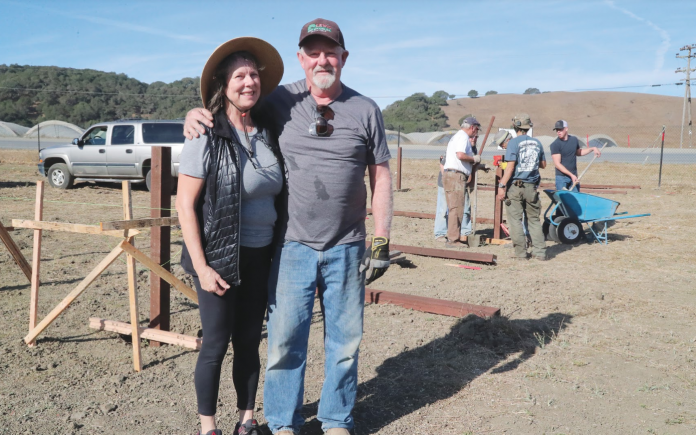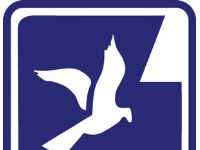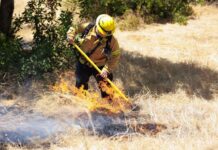
From the deck of the spacious hillside home of Wheeler and Cherry Edwards, you can see for miles. To the west, against the crimson smear of the setting sun, the railroad snakes through a pass in the hills toward the Pajaro Valley, in Monterey County. To your right stand the rugged blonde mountains that form the very southern edge of Santa Cruz County. And where you’re standing? That’s San Benito.
There in the middle distance, a few miles away, you can see a broad flat expanse of … well, let’s call it a blank canvas. It is the presumptive site of the A.R. Wilson Community Park, but it has remained closed, an idea in suspension, for more than two decades.
In a few months, the 17-acre parcel—owned by Aromas Community Center Foundation—may have the kind of activity you could even see from the Edwardses’ perch.
Imagine if you can the Aromas Dog Park.
Wheeler and Cherry share their home with three dogs: Bernie, their rambunctious Bernadoodle (a mix of a Bernese Mountain Dog and a Poodle); Lucy, their 15-year-old Soft-Coated Wheaten Terrier; and Daisy, a rescue dog who, like Lucy, is also a “Wheatie.”
When the Edwardses moved to Aromas in 2013 from Poulsbo, Washington, they quickly discovered that the county roads around their home were not designed for dog walkers. The local school has a soccer field where some will take their dogs, but dogs and children aren’t always an ideal mix.
But that the proposed sports park was a giant community space not being used. Might it be used as a safe space for dogs to run free while their owners fraternize?
The Aromas Community Center Foundation has for years been moving in the direction to build a multi-field sports park on the site, originally with two soccer fields and two baseball diamonds. And it has succeeded in erecting a perimeter fence, a parking lot, a storage shed and a bathroom facility. But the rest of the park has fallen victim to funding shortfalls.
In the meantime, Wheeler Edwards drew up a plan for much more modest and less expensive vision of the property. In the northwest corner of the parcel, he proposed two enclosed areas—one for small dogs, the other for larger ones—and a long perimeter walking trail, with trees for joggers, walkers and dogs on leashes. In the center would be the playing fields still to be built.
To Edwards and his wife, the dog park is more than a place to go with their dogs. It’s an experiment in community building. They are attempting to establish the park with donated time and money from the people of Aromas.
“There is no ‘them’ with this,” he said. “‘Them’ is us.”
Volunteers for the community are building the park, and they will be needed to maintain it. The inevitable problems of a shared public space—security, maintenance, upkeep—will have to be addressed by those who use the park, without looking to some institutional authority.
“I may be very naïve about it,” said Edwards, hovering over a drawing of his proposal. “But I want to be and continue to be a believer that a community will support this, if enough people have the passion to make this whole park a park for Aromas, not some company or outside architect, much like how community gardens evolve.”
The dog park idea turned a significant corner at Aromas Day, the community’s annual downtown festival, last August. The Edwardses and other supporters had an informational booth and shared the drawings of the proposed park. From the Aromas Day booth, they garnered more than 400 signatures from locals vowing to support the park and $750 to that end.
They brought the signatures to the board. Since then, said Cherry Edwards, “they’ve been super supportive. Once we showed them real support from the community, they were all over it.”
Somewhere around the beginning of October, the handmade signs began to appear around Aromas, soliciting help for a volunteer work day at the dog park. When that Saturday arrived, a few dozen people appeared at the dog park to lay the fence posts for the dog enclosure.
“It was an outstanding day,” said Wheeler Edwards. “We accomplished everything we wanted to, and more.”
Much of the raw building materials were already on site, donated by local companies and individuals. A small mountain of wood chips from local tree companies was there, to be spread across the ground where the dogs would play. There is very little to see now, but Wheeler can envision something beautiful: uniquely crafted archways over the gates, benches and shade trees all along the larger perimeter trail, which in the best-case scenario will act as a kind of community crossroads where neighbors may randomly encounter each other.
“In my eyes, it’ll never be done,” he said. “I don’t want it to be done. I want it to be open and people using it. But I like the imagination that’s going to go into it, and the ownership by the people of the community.”
In this do-it-yourself political era, the Aromas dog park represents an example of how a community might operate when it only has itself to answer to. Who’s going to pick up the garbage? Who’s going to lock the gate in the evening? Are dog owners going to be responsible for picking up the dog’s droppings? Inevitably, problems and conflicts will arise. How the community reacts to these challenges will define whether the dog park will be a success.
“What a cool opportunity to have a blank slate where you can do something colorful,” said Wheeler Edwards.
Wheeler is quick to admit that a community-built dog park is not an original idea. There is a dog park in Marina, divided for the use of small and large dogs, that serves as a model. “I remember thinking that if these people can do it, we can do it too,” he said.
The goal of Wheeler and Cherry Edwards and their supporters is to open the dog park for use in the early part of December. “We want to have a party,” said Wheeler. “We want to have a bonfire.”
“Once we start getting people down there,” said Cherry, “and get the gates open, the whole project will gain momentum. Other things will develop. Other ideas will happen. And people won’t have to worry about security so much, because there will always be someone there.”
“It’s so easy to get people motivated and excited,” added her husband. “Dog people are passionate people.”







